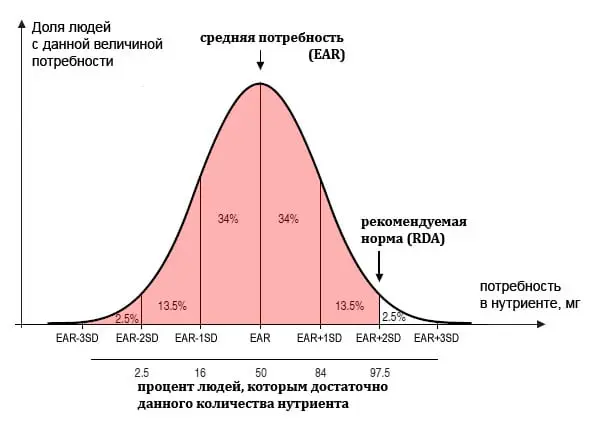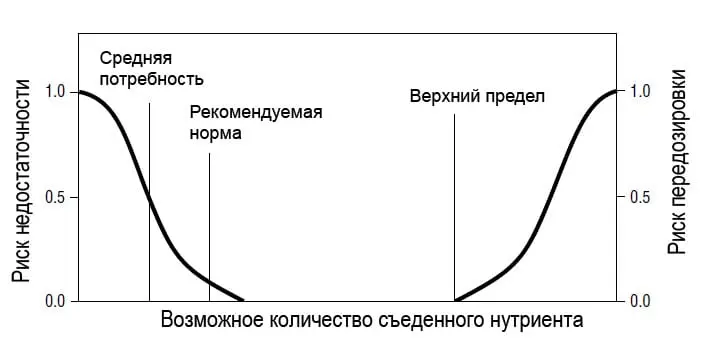
All of us, not even turning to precise instruments like the MWR, from time to time face claims “man during 1 day you should eat 1 gram of calcium”, “baby in winter needs vitamin D”, “pregnant women need to increase by 400 micrograms of folic acid”, etc. Where are these statements written? Who and what determines these numbers? What do they mean to a specific person? Let’s try to figure out.
The answer to the question “who?” apparently is the easiest one to understand: in polite countries, the government one way or another establishes standards, which focus on the work of doctors and organizations involved in nutrition and public health.
With the question of “how?” we will deal alongside the question “what”. In fact, what does this figure mean, if all people have different nutrient requirements? And to determine the needs of each particular person is very difficult, expensive, and often impossible.
For most nutrients for which it is possible to estimate the average demand and the magnitude of differences between different people, they usually do so:
- Assume that the needs of the people are “normal,” i.e., “bell curve” so-called normal distribution.
- Establish as the norm value in excess of the average demand for 2 standard deviations: Rate = Average demand + 2SD
Here’s how it looks:

In these “ideal” conditions this choice of variables gives us the requirements for approximately 97.5% of the representatives of this group, i.e. 97.5% (most people) HAVE LESS THAN the PRESCRIBED NORM.
In fact, often the real situation is with the required value and its distribution is much more complicated. For example:
- The need for some nutrients may depend on their habitual consumption (e.g., known about the vitamin C and Pro-calcium a few months the body can readjust to the new level of consumption. Even describes some of the symptoms of scurvy in humans, dramatically reduced the intake of vitamin C with greatly excess to normal.
- The level of need measured for synthetic drugs, but how much of that substance is absorbed from real food, modern science does not know (for example folic acid, the bioavailability within the real products are little studied).
- There are many other factors that hinder the measurement requirements for nutrients.
In all such cases to the calculation of suitable norms of the classic considerations of “do no harm” standards inflated so that even in the worst case to guarantee that the vast majority of people lack nutrient deficiency. About certain nutrients sometimes it is noted that subsequent research can change the rules to decrease that in recent years some regulations have already occurred.
In many cases, however, it is not possible to determine even the average demand (the reasons may be different). Some (e.g., choline) in General are still not exactly known whether this nutrient should be in the diet of all people, or the majority lack an endogenous quantity. In such cases, the norm is taken to be the average consumption in the population group in which people are healthy and show no signs of deficiency for this nutrient.
Such provisions are indicated in foreign literature AI (adequate intake – adequate intake), unlike the above-described “more precisely defined” norms referred to as RDA and EAR (Estimated Average Requirement – estimated average requirement and Recommended Dietary Allowance – recommended intake). In our rules, there is no such separation. The origin of standards is on the website of the Academy of Sciences. Here’s what you can learn about the rules of various nutrients:
| Nutrients are defined estimated average requirement (EAR) and installed the recommended allowance (RDA) | Nutrients that have only adequate sufficient (Adequate Intake, AI), real average requirement is not precisely defined |
|---|---|
| vitamins a,C,B1,B2,B3,B6,B9,B12,E, iron,zinc, phosphorus, copper, iodine, magnesium, selenium, molybdenum | vitamins D,K,B5 (Pantothenic acid), choline,Biotin, calcium, potassium, sodium, chromium, fluorine, manganese |
As you can see, even with the very balance of some of the studied elements have many not fully elucidated points.
Also, for some nutrients is determined, in addition to lower standards, “tolerable upper level” (UL, upper level). Usually, it is chosen so that the probability of the risk of side effects from excess nutrients was close to zero. So, roughly, is the ratio of these variables and risks associated with a lack of or excess of nutrient:

What are the implications of all this to make us, the consumers?
First, do not be afraid, if the amount of some nutrient in our diet is not up to 100%. As can be seen from the definitions, most people need much less than normal, though, the closer we get to the chosen norm, the more likely that everything will be fine.
Second, we must understand that in certain cases these rules may not be suitable to a specific person, and not to guarantee the coverage of individual needs in a particular substance. Here are a few typical examples of the above-mentioned American publications:
| A factor to consider | Nutrient | Adjustment |
|---|---|---|
| Recommended the acceptance of artificial vitamins | Folic the for pregnant | All pregnant women, and having the ability to get pregnant recommended +400 µg folic to-you in addition to the standard dose derived from food. |
| Vitamin B12 for people over 50 years | Shown to take B12 this category of people. | |
| Smokers | Vitamin C | The recommended daily dose of vitamin C for smokers is increased by 35 mg |
| A vegetarian diet | Iron | Requirements of iron for vegetarians are multiplied by 1.8 because of the worst absorption of iron from plant sources |
| Zinc | Need for zinc for vegetarians are increased by 50% due to a worse absorption of zinc from plant sources | |
| Age of menstruation | Iron (norms mean the beginning of menstruation at 14 years of age) | If menstruation began before the age of 14, is added 2.5 mg/day to compensate for losses. On the contrary, if after 14 menstrual period has not started yet, need to take 2.5 mg/day. |
| Athletes, exercise regularly | Iron | Average demands are increasing by 30-70% |
| The norm is calculated by the weight of the person | Proteins | To count proteins in accordance with the weight |
| The norm is calculated according to the caloric | Dietary fiber | To convert the rule in accordance with the caloric intake |
Also, you should know that excessive alcohol consumption may lead to a deficiency of almost half of the nutrients (A, C, B2, B6, B3, folic-TA, zinc, etc.).
A very big impact on the deficit of nutrients can have different drugs and diseases. The list is clearly beyond this article, just be sure to check to root and/or taking medications that the nutrients must be replenished in your case (experience shows that most doctors usually do not bother with such an issue).
Now, building your diet in accordance with the calories recommended ranges B/W/Y and norms of micronutrients, you will be able to more rationally understand that behind the numbers rules, as well as in what cases and to what extent you can rely on them. Delicious and nutritious food waiting for you!









